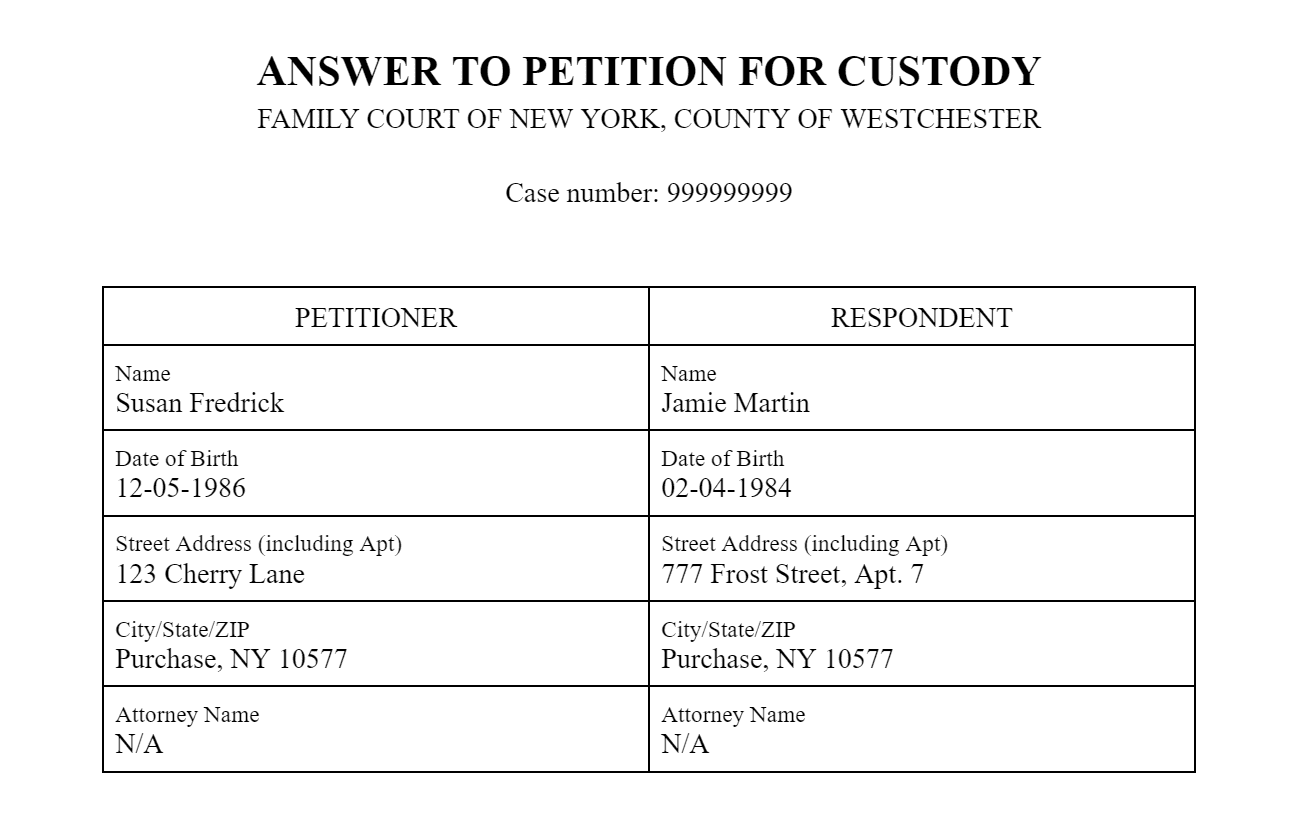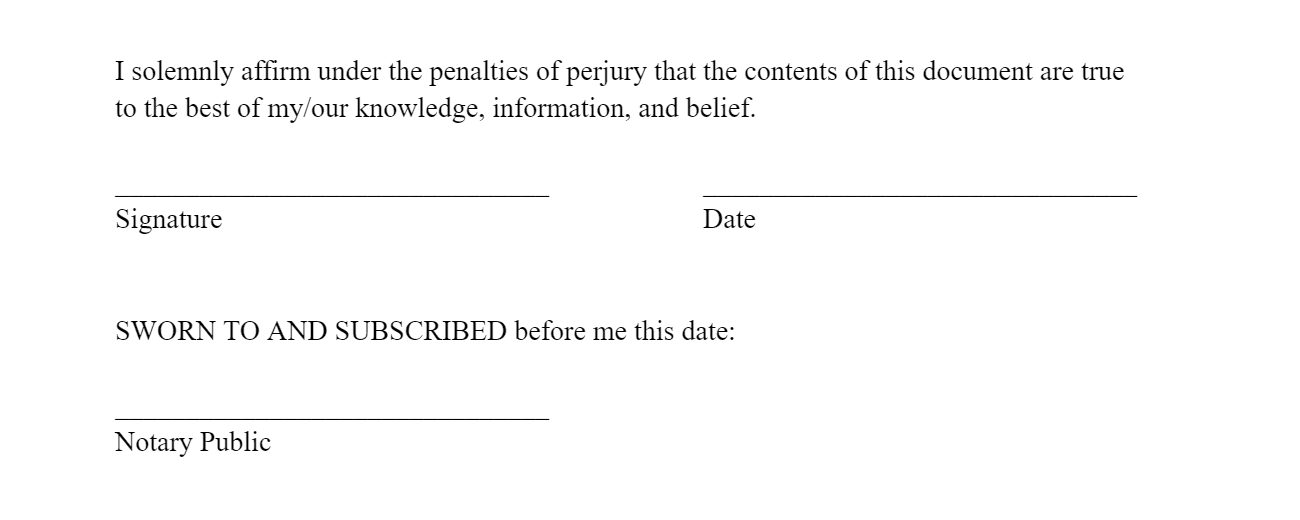
If you disagree with anything the other parent is asking for, you should respond with an answer and counterclaim for child custody. Responding allows you to clarify anything and tell the court what you want. You can use our free templates below.
If you're divorcing, your response will also have to address matters like property division.
Visualize your schedule. Get a written parenting plan. Calculate your parenting time.
If you're served custody papers, someone has opened a child custody case against you. You'll receive your petition and summons in the mail, in person or through email.
A petition explains what the other parent is asking for. The summons tells you the location, date and time of the first court hearing, mediation or other event required by the court.
Read the petition and summons carefully. Figure out exactly what the parent is asking for, any documents you must supply and the deadlines by which you must hand them in. Call the court if you're having trouble locating this information.
Take note of the titles given to each parent. The parent who filed for custody first will either be the petitioner or plaintiff and you'll be the respondent or defendant.
Consider hiring a lawyer or finding a legal aid office if you're unsure of what to say in your response.
Some states have answer and counterclaim templates. (See States with forms below.) Otherwise, you can hire a lawyer to draft your response or write your own. You can also use our downloadable templates:
In your response, you can refer to yourself as I or the title given to you in the custody petition (respondent or defendant). Refer to the other parent as mother, father, another title they go by or their role in the court case (petitioner or plaintiff).
As you fill in your forms, write N/A for anything that does not apply to your case.
Your response will focus on the petition. To respond to a summons for child custody, show up at the time and place stated on the document.
An answer is your response to the claims in the petition. You'll specify which parts of the petition you agree with, which parts you disagree with and which you don't know about. Your answer can address errors like incorrect dates and locations, plus whether you agree with what the petitioner is asking for (e.g., the type of custody).
Title and header

Generally, you'll title your form Answer to Petition for Custody, but your court may prefer different terms. Your court might call answers responses and petitions complaints. Plus, not all states use the term child custody, and child custody cases aren't always heard in family court. Look at your state's custody laws to figure out the terminology you should use. If you're using our fillable template, you can type in the correct terms.
Your header should include the same information that is at the top of the petition: the case number, names of the parties involved, their addresses, dates of birth, lawyers' names, etc.
The body of your answer is where you'll respond to the petitioner's claims.
Respond to the custody petition paragraph by paragraph. State whether you admit or deny each claim. If you admit something, that means you agree. If you deny, it means you disagree. You could state "I don't know" in relation to anything you're uncertain of. Precede each response with the number of the paragraph you're addressing.

If you don't plan on writing a counterclaim, you can attach a proposed parenting plan or custody schedule to show your ideal parenting arrangement. Sometimes this is required by the court.
Signature section
The bottom of your answer should have space for you and a notary to sign and date your document. Don't sign until you're in front of the notary.

A counterclaim allows you to ask the court to grant the arrangements you want.
Title and header
Format the top of your form like the answer. Swap out the word Answer with Counterclaim or whichever term your court prefers. If you're using our fillable template, type in the terms used by your local court.
Start with a formal statement of "I, [your name], state that. ", followed by your first numbered paragraph, which should state the type of document you're responding to. (From here on out, you'll number the paragraphs.) Paragraph 2 should state your relation to the children.

After you list your children's names and dates of birth, put a paragraph listing your children's current address and whom they live with. Put your children's previous addresses and whom they lived with in the subsequent paragraph.

In the paragraphs that follow, state whether you or the other parent have been involved in any other cases about these children. You'll attach the court orders you have for these cases. Also, list the names of anyone else who is not involved in the case but has physical custody of the children or claims they have a right to physical custody.
The rest of your counterclaim should look similar to the petition with numbered paragraphs briefly stating what you want and why you believe you should get it. For each counterclaim, explain why you believe your desired arrangement is in the best interest of the child.
You could attach a parenting plan to propose a custody schedule and any other terms you'd like the court to order.
Signature section
Designate a spot at the bottom of the form to sign your counterclaim. Wait until you're in front of a notary public to sign it.

It's a good idea to have your forms looked over by a legal professional. Some courts have family law facilitators or other staff members who can review your paperwork to make sure it's court-acceptable. Then, make two copies of each form. Sign the originals in front of a notary public.
Typically, you'll take your answer and counterclaim for child custody to the same court listed on the petition and summons. The court clerk will stamp all your forms with the date, time and possibly a file number. Most likely, you'll have to pay a filing fee. If you cannot afford it, ask for a fee waiver.
You must serve the other parent with copies of your response to the custody petition. Some courts require process servers to serve the other parent, while others allow parents to serve the papers through mail or hand delivery. You'll then have to file proof of service. Many courts have a specific form for this.
The other parent will have the opportunity to respond to your answer and counterclaim for child custody. If they do, you'll receive copies of their response.
Be sure to attend the hearing, conference, mediation session or other court date indicated on the summons.
If you don't respond within the number of days specified by your local court, the other parent can file paperwork asking the court to enter a default judgment against you. If the court approves, the parent gets everything they asked for in the custody petition.
Generally, you don't have to file an answer if you agree with everything the other parent is asking for. Make sure you have a written agreement to turn in to the court. Otherwise, the other parent could change their mind and ask the court to hold you in default.
The following states have answer or counterclaim forms or instructions on how to respond online.